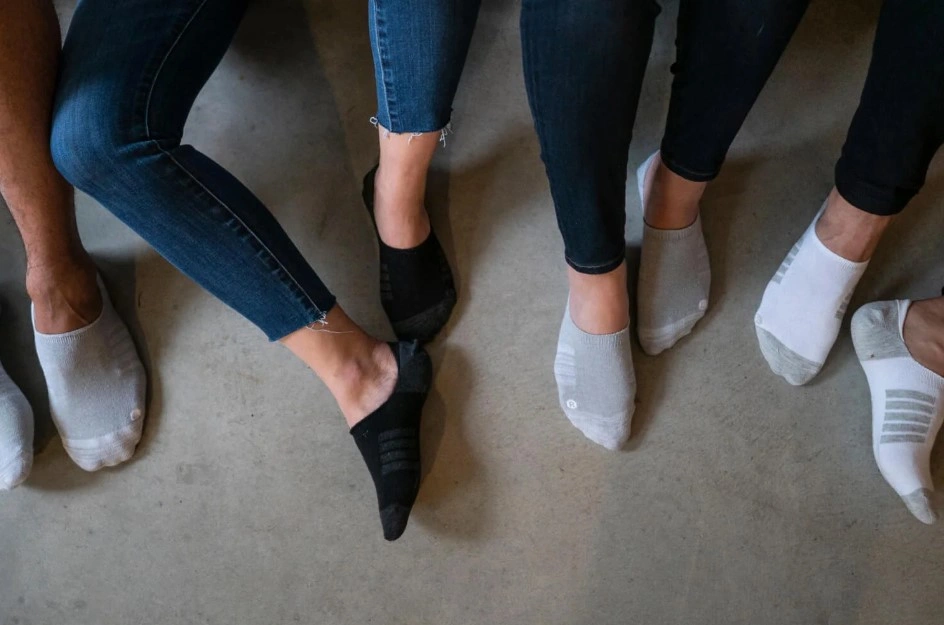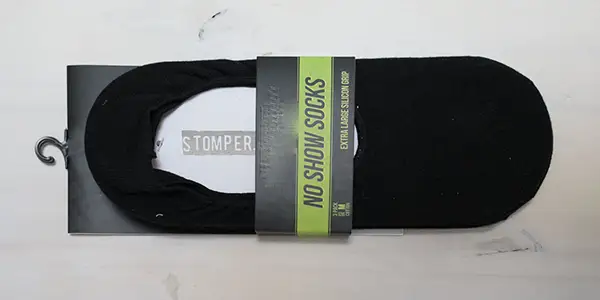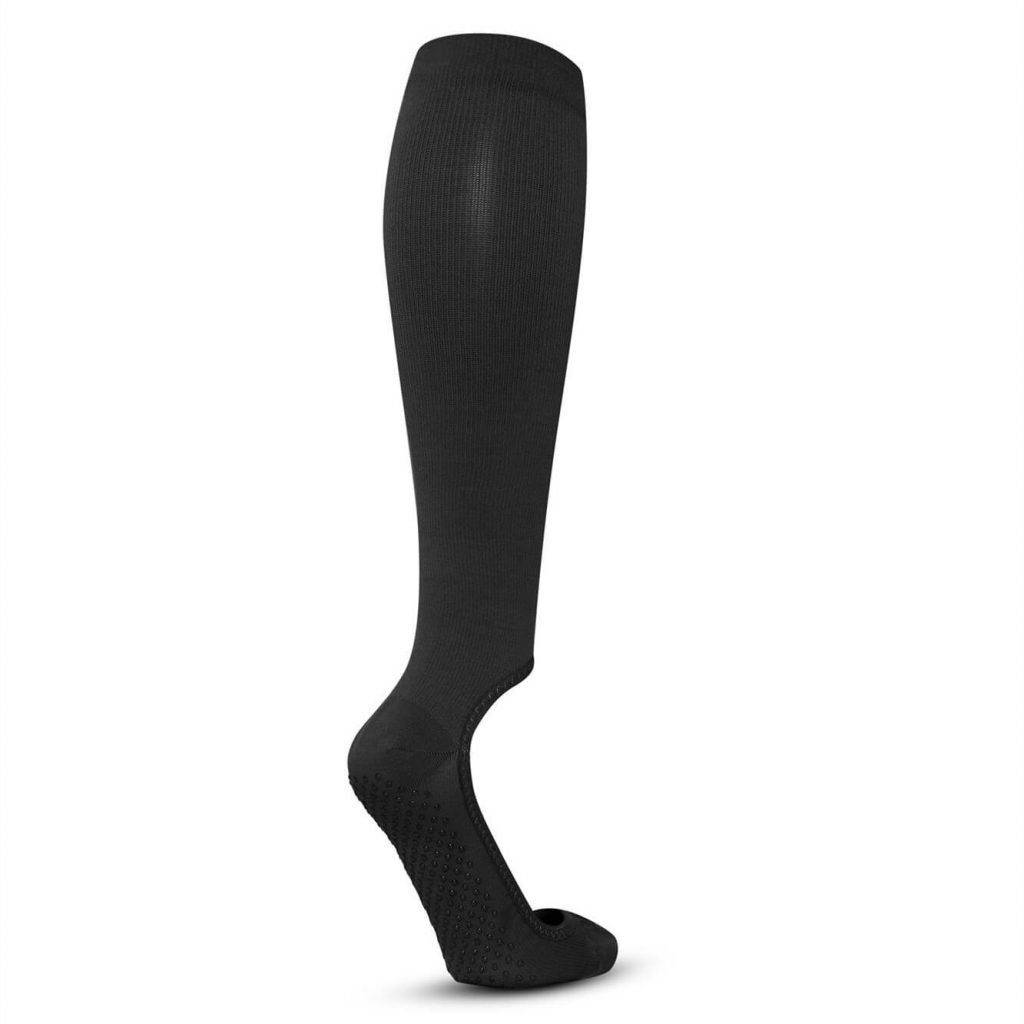Introduction: Navigating the Shifting Tides of Hosiery Fashion
No-show socks remain a key product in the hosiery market, but shifting consumer preferences and fashion cycles are changing their role. For apparel brands and manufacturers, understanding these trends is essential for product planning and marketing. While some sources claim no-show socks are losing popularity, they continue to offer comfort and style in many contexts. This guide analyzes current market trends, consumer behavior, and design innovations. At Max Hosiery, we help brands adapt by creating no-show sock lines that balance functionality and fashion, keeping you competitive in today’s evolving hosiery market.

Defining the Invisible: What Exactly Are No-Show Socks?
No-show socks, also known as invisible socks or footies, are designed to remain hidden when worn with shoes. This makes them distinct from traditional sock styles and central to their appeal in the hosiery market. Understanding these design basics is essential for brands evaluating their market potential.
The hallmark of no-show socks is their low-profile cut. Unlike crew or ankle socks that rise above the shoe line, no-shows sit just below the shoe collar. This placement creates a clean, “sockless” look while still providing a protective layer between the foot and footwear. The fabric is thin and designed to blend with the skin, maintaining the illusion of bare ankles.
Design precision ensures these socks stay concealed. The fabric around the heel, sides, and toe is minimized and contoured to the foot’s shape, preventing the sock from slipping or showing. To address the common issue of heel slippage, many no-show socks feature silicone grips or gel pads on the inside heel area. These grips, combined with elastic materials, help the sock stay firmly in place during walking or running.
The primary purpose of no-show socks is practical: they offer the benefits of wearing socks—comfort, moisture control, and hygiene—without compromising style. They prevent discomfort, reduce odor, and protect feet from direct contact with shoes, which can cause blisters or irritation.
This combination of invisibility and function drives the ongoing demand for no-show socks, making them a staple for brands aiming to meet consumer needs for comfort and style in one product. the accompanying discomfort, odor, and hygiene issues that arise from direct skin-to-shoe contact. This core utility is a foundational element in evaluating their ongoing relevance in the market.
The Ascent of Invisibility: The Era When No-Show Socks Ruled
No-show socks didn’t just appear overnight; their meteoric rise to prominence was intricately linked with broader fashion trends that emphasized a cleaner, minimalist aesthetic and the “sockless” look. This era, spanning roughly the late 2000s through the mid-2010s, saw no-show socks transition from a niche accessory to a true wardrobe staple for millions. Understanding the driving forces behind this past popularity is crucial for brands assessing their current market position and forecasting future demand.
What fueled this surge in popularity?
- The “Sockless” Trend: The primary catalyst was the widespread embrace of the sockless trend, particularly among men. From loafers and boat shoes to sneakers and even some dress shoes, the bare ankle became a sign of casual sophistication. However, going genuinely sockless often led to sweaty feet, unpleasant odors, friction blisters, and premature wear on footwear. No-show socks emerged as the perfect intermediary, offering the desired aesthetic without the practical downsides.
- Versatility Across Footwear: No-shows proved incredibly versatile, seamlessly pairing with a wide array of shoe styles where traditional socks would clash or simply look awkward. This included ballet flats, espadrilles, slip-on sneakers, low-cut athletic shoes, and various casual and semi-formal footwear options. Their chameleon-like ability to adapt to diverse shoe types made them an indispensable item in many wardrobes.
- Comfort and Hygiene Solution: Beyond aesthetics, no-show socks addressed genuine comfort and hygiene concerns. They provided a soft, absorbent layer that wicked away sweat, reduced friction, and protected the foot from direct contact with shoe materials, thereby minimizing blisters and preventing odor buildup in footwear. This practical appeal resonated deeply with consumers who valued both appearance and well-being.
- Minimalist Fashion Influence: The broader fashion landscape during this period often favored clean lines, understated elegance, and a less-is-more approach. Visible socks could be perceived as interrupting this streamlined aesthetic, making the invisible sock an ideal choice for a polished, uncluttered look.
The result was clear. No-show socks became a go-to option for both men and women, establishing themselves as a powerful segment within the hosiery market. Brands that capitalized on this trend saw significant growth, underscoring the importance of aligning product offerings with prevailing consumer desires and solving practical problems.
The Shifting Tides of 2025: Are No-Shows Taking a Back Seat?
No-show socks have long been a staple in the hosiery market, prized for their discreet, minimal look. However, 2025 marks a notable shift as changing consumer preferences—especially among Gen Z—challenge this once-dominant style. Reports suggest no-show socks are “taking a back seat,” signaling a shift in the fashion landscape that hosiery brands must understand to stay competitive.
The Rise of Visible Socks
One major factor driving this change is the resurgence of visible sock styles. Gen Z leads the movement toward crew-length and higher-cut socks, often featuring vibrant patterns, bold graphics, and pastel colors. These socks have evolved from mere functional accessories into intentional fashion statements. Instead of hiding socks, wearers are now highlighting them as a key part of their outfit.
Breaking Fashion Rules with Sock Pairings
This trend extends to unconventional sock and shoe combinations. Crew socks paired with footwear like UGGs, Mary Janes, and even sandals reflect a break from the “bare ankle” look that once popularized no-shows. The new mantra emphasizes “socks that show up and show out,” embracing visibility and personality.
Fashion as Personal Expression
For many younger consumers, socks are no longer just practical—they are tools for self-expression. Minimalist no-shows lack the visual impact that colorful, patterned socks bring. This preference for bold, playful styles directly contrasts with the understated appeal of no-shows.
The Role of Social Media
Platforms like TikTok and Instagram accelerate these shifts by spotlighting eye-catching sock styles. Influencers popularize new looks that rapidly influence millions, making visible socks a cultural phenomenon.
For hosiery brands, this evolving preference means reevaluating no-show socks’ place in the market. While not obsolete, they must adapt product lines and marketing strategies to engage a consumer base increasingly drawn to visible, expressive sock styles.visible styles.
Gen Z’s Impact: The Driving Force Behind New Sock Aesthetics
Gen Z, born between the mid-1990s and early 2010s, plays a major role in changing sock trends. Their unique values and lifestyle choices are driving a shift away from the traditional popularity of no-show socks, forcing brands to rethink design and marketing strategies.

Redefining Sock Visibility and Style
This generation challenges old fashion rules, rejecting the idea that socks should be hidden. For Gen Z, visible socks paired with sneakers or boots are a bold fashion statement that expresses individuality. They see no-show socks as limiting and prefer styles that stand out, embracing ankle and crew socks as part of their everyday look.
Prioritizing Comfort and Functionality
Comfort is key for Gen Z consumers. Full-length socks often provide better warmth, stay in place more reliably, and pair well with casual footwear like sneakers or UGG boots. Their preference for comfort-driven fashion naturally supports visible sock styles that balance practicality with trendiness.
Nostalgia Meets Modern Trends
Gen Z’s love of retro styles brings back visible sock trends from the 80s and 90s, blending vintage aesthetics with contemporary fashion. This revival connects with their desire for authenticity and self-expression, creating a renewed market for crew and ankle socks.
Sustainability and Durability
Sustainability matters deeply to Gen Z. They favor versatile, durable socks that last, over fragile, specialized no-shows. This preference supports investment in high-quality crew socks that fit various styles and reduce waste, aligning with eco-conscious consumer values.
For brands, adapting means expanding visible sock offerings without abandoning no-shows. Innovating in design while responding to Gen Z’s demands for boldness, comfort, and sustainability will be essential to remain competitive in the evolving hosiery market.ers.
Are No-Show Socks Truly “Out of Style”? A Nuanced Perspective
Fashion cycles rarely erase a trend completely. Although visible socks have surged on runways and social feeds, no-show socks still hold a place in the broader hosiery market. Brands that write off invisible socks risk missing niche opportunities driven by practical needs and diverse style preferences.
Versatility in Footwear Pairings
No-show socks adapt to various shoe types—loafers, boat shoes, ballet flats, and low-profile sneakers—where a bare-ankle look remains desirable. In professional settings or warm climates, visible socks can clash with dress codes or feel too heavy. Invisible socks deliver a polished finish while preventing blisters and managing moisture. This functionality maintains steady demand even as fashion conversations shift elsewhere.
Diverse Consumer Profiles
Younger shoppers may favor colorful, statement socks, but Millennials, Gen X, and Baby Boomers often stick with minimalism. Their workwear requirements, comfort priorities, and habit patterns still align with invisible hosiery. Brands can segment marketing to highlight how no-show socks support different demographics, leveraging SEO phrases like no-show socks trend and invisible socks for work to capture searchers across age groups.
Context-Driven Demand
Certain settings—boardroom presentations, summer weddings, or yacht outings—expect a sockless aesthetic. In these scenarios, no-show socks offer a hygienic barrier without breaking the style code. Recognizing these use cases lets brands position invisible socks as a practical staple rather than an obsolete item. By recalibrating production and messaging toward these niche moments, manufacturers can sustain relevance in a dynamic hosiery landscape.
Situations Where No-Show Socks Remain Essential
Even amid visible-sock popularity, no-show socks deliver specific benefits that keep them in active rotation. For hosiery brands, identifying these key situations helps secure a stable revenue stream and reinforces the practicality of invisible socks.
Footwear That Demands Discretion
Shoes designed for a clean silhouette—ballet flats, deck shoes, driving moccasins—require a hidden sock. Visible hosiery here risks disrupting the intended look. No-show socks preserve the designer shoe aesthetic while managing sweat and friction. Highlighting this in product descriptions with keywords like hidden comfort and low-cut socks strengthens SEO relevance.
Athletic and Casual Comfort
Many runners, gym enthusiasts, and casual sneaker wearers prefer no-show socks for a minimal feel. These socks reduce chafing and wick moisture without adding bulk. Fabrics engineered for grip and breathability make them a performance choice, not just a style one. Emphasize this crossover in marketing copy to capture searches such as performance no-show socks and sweat-wicking invisible socks.
Climate and Hygiene Considerations
In hot weather, visible layers can feel restrictive. No-show socks offer airflow around the ankle while keeping feet dry. For daily commutes or extended wear, invisible socks also shield shoes from odor and interior wear. Framing no-shows as a hygiene solution taps into moisture control socks search intent and positions them as a health-conscious option.
By detailing these scenarios, brands showcase no-show socks not as a fading fad but as a targeted solution for specific needs. This nuanced framing supports SEO strategies and underscores the enduring value of invisible hosiery.
Manufacturing Implications: Adapting Production to Evolving Trends
Shifts in no-show sock demand carry direct consequences for manufacturing strategy. Hosiery brands must align production, sourcing, and quality control with market movements to optimize costs and meet customer expectations.
Flexible Production Planning
Allocating capacity between invisible and visible socks requires data-driven forecasting. Invest in adaptable machinery that handles various sock lengths—ultra-low no-shows to mid-calf crews—without lengthy changeover times. This agility reduces overstock risks and ensures quick response to emerging trends, boosting operational efficiency.
Upgrading No-Show Performance
Remaining no-show customers expect higher functionality. Focus on innovations like advanced silicone gripping methods to prevent slipping, reinforced stress zones at heel and toe, and moisture-wicking yarns that balance thinness with durability. These enhancements meet consumer demands for invisible socks that perform under diverse conditions.
Strategic Material Sourcing
Visible sock lines may prioritize vibrant colors and complex knits, while no-shows depend on premium elastane blends and non-slip additives. Adjust yarn procurement to match each category’s requirements. Building strong supplier relationships for specialized fibers helps maintain consistent quality and competitive lead times.
Quality Control Tailored to Sock Type
Quality checks for no-show socks should emphasize grip retention after washes and maintaining a low cut. For visible socks, inspect colorfastness, pattern alignment, and uniform thickness. Implementing distinct QC protocols prevents defects and reinforces brand reputation in both segments.
Manufacturers that adopt this segmented approach—combining production flexibility, material optimization, and targeted quality standards—will thrive in the evolving hosiery market. By matching manufacturing capabilities with consumer expectations, brands secure a competitive edge and sustainable growth.
The Future is Functional: Improving No-Show Sock Performance
Even as fashion trends shift, no-show socks retain value through performance and comfort. Brands that invest in targeted innovation will lead the market by addressing real wear-and-tear and fit issues.
Advanced Non-Slip Solutions
Heel slip frustrates many no-show wearers. Next-generation socks will use embedded silicone zones or gel-infused yarns knit directly into the fabric. These built-in grips boost traction inside various shoe linings, ensuring the sock stays in place without bulky silicone strips.
Adaptive Fit and Zoned Support
A tailored fit across foot shapes and shoe types is vital. Zoned compression in the arch, an articulated heel pocket, and stretch-memory fibers allow the sock to mold to individual feet. This adaptive fit cuts down on bunching and pressure points, improving comfort in sneakers, loafers, and flats alike.
Moisture Control and Odor Defense
Worn in low-ventilation footwear, no-show socks need proactive moisture management. Blends of Coolmax fibers and merino wool draw sweat away from skin, while silver-infused yarns inhibit bacterial growth. The result is drier, fresher feet and a lower risk of blisters or fungal issues.
Built-In Durability
Minimalist no-show designs often wear out quickly. Reinforcing high-stress areas—heel, toe, and ball of foot—with high-strength polyamide yarns or tighter knit patterns extends sock lifespan without adding thickness.
Footwear-Specific Models
Generic no-show socks meet basic needs, but specialized versions will gain traction. Think “Sneaker No-Show” with extra cushioning under the heel or “Ballet Flat No-Show” with ultra-slim edges. Tailoring design to footwear type deepens brand loyalty and justifies premium pricing.
By focusing on these innovations—non-slip grip, adaptive fit, moisture control, reinforced durability, and footwear-specific lines—brands can keep no-show socks relevant through their practical advantages.
Marketing Strategies: Positioning Hosiery for a Dynamic Market
In a landscape where consumer tastes shift fast, hosiery brands must blend clear messaging with targeted outreach. Effective marketing turns a basic sock into a must-have accessory.
Segmented Campaigns
No-show socks and visible designs appeal to different users. Craft separate messages: promote no-show for “secure fit” and “foot health,” while visible crew and ankle socks focus on “pattern play” and “outfit accents.” Using targeted ads or email lists ensures relevance for each segment.
Function-First Education
Highlight real benefits: terms like “non-slip grip,” “odor-control yarns,” and “all-day comfort” resonate with search queries such as no-show socks fit and moisture-wicking socks. Blog posts or short videos demonstrating how your socks solve common issues drive organic traffic and backlinks.
Visual Storytelling for Visible Styles
Leverage Instagram or TikTok to show crew and graphic socks in action. Partner with streetwear influencers who can style visible socks with unconventional outfits. High-quality imagery and short reels boost engagement and position your brand as trend-savvy.
Material and Design Highlights
Feature premium fabrics—bamboo blends, recycled polyesters—or innovative knits in product pages. Detailed descriptions, close-up photos, and micro-site sections on “why this yarn matters” support SEO around terms like premium hosiery and sustainable socks.

Influencer and Seasonal Tactics
Collaborate with micro-influencers in fitness, travel, and fashion niches to share authentic reviews. Time promotions to seasons and events—market breathable no-shows for summer travel and plush crew socks for winter sports—to tap into timely searches and shopper intent.
By combining precise audience targeting, function-driven content, compelling visuals, and strategic partnerships, hosiery brands can stay agile and maintain strong market position as trends evolve.
Conclusion: Navigating the New Era of Hosiery with Strategic Insight
No-show socks are no longer the leading fashion statement but remain essential for their function and discreet style. Brands must balance visible, trendy socks with high-quality no-shows that offer superior comfort, grip, and hygiene. Success depends on adapting product lines and marketing strategies to meet diverse consumer needs.
Partnering with an expert manufacturer can provide the innovation and market insight needed to stay competitive.
Ready to evolve your hosiery line for today’s market? Contact Max Hosiery for a free consultation and let’s create your next standout sock collection.
FAQ Section
Q1: What does “no-show” mean for socks?
“No-show” refers to a sock designed to be invisible when worn with shoes. It has a very low-cut profile, typically with a thin band of fabric across the top that sits below the shoe line, creating the appearance of a bare ankle.
Q2: Is Gen Z really not wearing no-show socks?
Gen Z is indeed leading a trend towards visible socks, particularly crew-length styles in bold patterns, and often pairs them with shoes where no-shows were traditionally worn. However, this doesn’t mean they’ve entirely abandoned no-shows; it’s a shift in dominant fashion preference.
Q3: Are no-show socks still relevant for specific types of shoes?
Yes, no-show socks remain essential for shoes like loafers, boat shoes, ballet flats, and certain low-profile sneakers, especially when the wearer desires a “sockless” aesthetic while still benefiting from comfort, hygiene, and blister prevention.
Q4: What should brands focus on if they continue to produce no-show socks?
Brands should focus on enhancing the functionality and comfort of no-show socks. Key areas for innovation include superior non-slip technology, advanced moisture-wicking materials, reinforced durability, and specialized designs for specific footwear types.
Q5: What’s the main difference in marketing between no-show and visible socks now?
Marketing for no-show socks should now emphasize their functional benefits (comfort, hygiene, no-slip fit, blister prevention). In contrast, marketing for visible socks should focus on fashion, self-expression, patterns, and unconventional styling to align with current trends.
